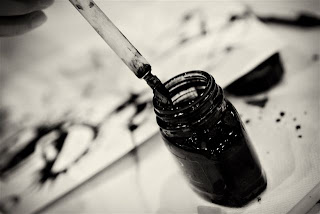Acrostic poems are easy to write, the first letter, syllable or word of each line in the poem spells out a word or message. Good for writing secrete coded messages!
 |
| Sister |
Joe's wrote about his sister;
Silly
Infant
Trip
Electric
Roar!
1. choose a word for your subject, it could be a name, or an activity...
2. write that word in big bold letters vertically going down the side of your piece of paper (or you could cut letters out of newspapers or magazines and stick them down.)
3. think of lots of words that fit with the subject, don't worry if they fit with the letters, list as many as you can think of
4. look through your list of words, and think about how they could fit in the poem
5. when you're sure write them down.
In Lewis Caroll's Through the Looking-Glass, the final chapter is an acrostic of the real Alice's name: Alice Pleasance Liddell.
A boat, beneath a sunny sky
Lingering onward dreamily
In an evening of July -
Children three that nestle near,
Eager eye and willing ear,
Pleased a simple tale to hear -
Long has paled that sunny sky:
Echoes fade and memories die:
Autumn frosts have slain July.
Still she haunts me, phantomwise,
Alice moving under skies
Never seen by waking eyes.
Children yet, the tale to hear,
Eager eye and willing ear,
Lovingly shall nestle near.
In a Wonderland they lie,
Dreaming as the days go by,
Dreaming as the summers die:
Ever drifting down the stream -
Lingering in the golden gleam -
Life, what is it but a dream?
Lingering onward dreamily
In an evening of July -
Children three that nestle near,
Eager eye and willing ear,
Pleased a simple tale to hear -
Long has paled that sunny sky:
Echoes fade and memories die:
Autumn frosts have slain July.
Still she haunts me, phantomwise,
Alice moving under skies
Never seen by waking eyes.
Children yet, the tale to hear,
Eager eye and willing ear,
Lovingly shall nestle near.
In a Wonderland they lie,
Dreaming as the days go by,
Dreaming as the summers die:
Ever drifting down the stream -
Lingering in the golden gleam -
Life, what is it but a dream?
































